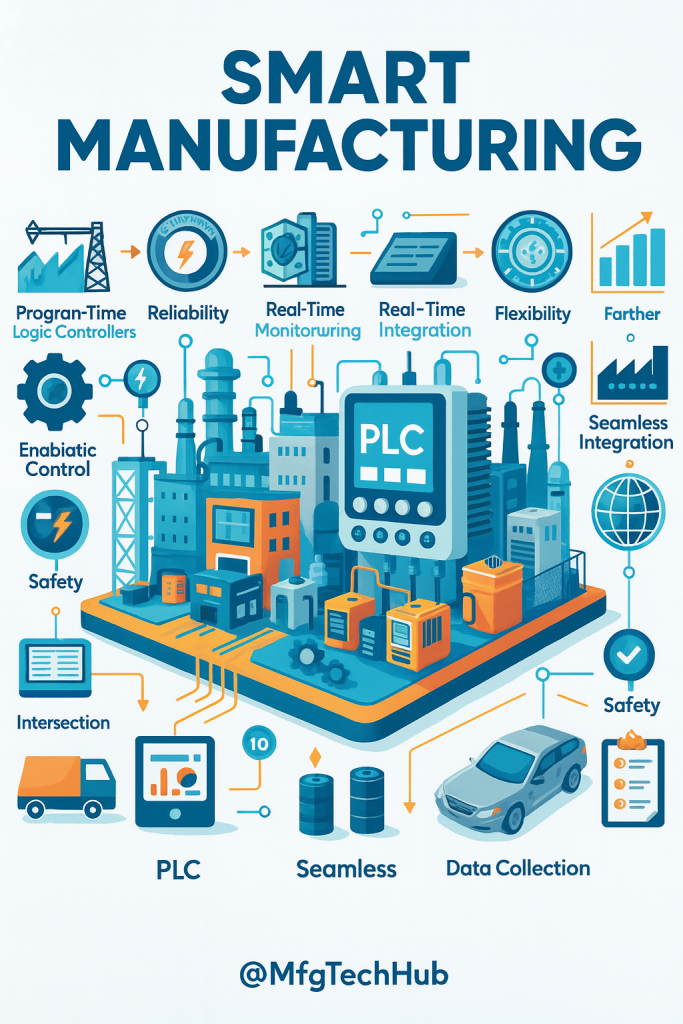PLCs Importance in Industrial Automation
Industrial automation has transformed how industries operate, making processes more efficient, reliable, and cost-effective. At the heart of this transformation is the Programmable Logic Controller (PLC)—a robust, flexible, and highly efficient control system that enhances productivity and minimizes human intervention.

PLCs play a critical role in manufacturing, energy, infrastructure, and countless other sectors, ensuring precise monitoring, control, and automation of industrial processes. Their ability to replace manual operations, eliminate errors, and provide real-time monitoring makes them an essential technology for industrial growth.
In this article, we will explore why PLCs are indispensable in industrial automation, the key benefits they offer, and how they contribute to modern and future industries.
1. The Need for Automation in Industries
Before the advent of automation, industries relied on manual control systems, mechanical relays, and timers to regulate production processes. These systems had several limitations, such as:
- High operational costs due to labor-intensive processes
- Frequent human errors leading to inconsistent production quality
- Slow response time to system failures or changes in conditions
- Complex wiring and maintenance issues
To overcome these challenges, industries shifted towards automation, where machines could perform repetitive, precise, and high-speed tasks with minimal human intervention. PLCs emerged as the ideal solution, providing industries with programmable, scalable, and highly reliable control systems.
2. Why PLCs are Essential for Industrial Automation

PLCs are the backbone of industrial automation due to their ability to process inputs, execute logic-based decisions, and control outputs in real time. They replace manual processes and provide the following advantages:
A. Reliability and Precision
PLCs are highly reliable and can operate 24/7 in harsh environments. Unlike human operators, PLCs do not experience fatigue, distractions, or inconsistency. They execute programmed instructions with extreme accuracy, ensuring:
- Consistent product quality
- Reduced manufacturing defects
- Efficient resource utilization
B. Speed and Efficiency
PLCs process inputs and make control decisions within milliseconds, ensuring that industrial processes run at optimal speed. This improves production throughput, reduces cycle times, and enhances overall operational efficiency.
Example: 
C. Flexibility and Scalability
Unlike hardwired relay systems, PLCs can be easily reprogrammed to accommodate new processes, machine configurations, or production changes. This flexibility allows industries to adapt to market demands without replacing entire control systems.
Example: 
D. Real-Time Monitoring and Control
PLCs continuously monitor industrial processes, collecting real-time data from sensors and devices. This data helps in:
- Predictive maintenance – Identifying faults before they cause breakdowns
- Process optimization – Adjusting parameters for maximum efficiency
- Reducing downtime – Quickly diagnosing and resolving issues
Example: 
E. Energy Efficiency and Cost Reduction
By optimizing industrial processes, PLCs help reduce energy consumption and minimize operational costs. Automated systems:
- Shut down idle machines to save power
- Optimize production schedules to prevent overuse of resources
- Monitor energy usage to identify inefficiencies
Example: 
3. Industries That Depend on PLCs
PLCs are used across multiple industries, each with specific automation needs. Here’s how they enhance different sectors:
A. Manufacturing and Production
PLCs control assembly lines, robotic arms, material handling, and quality control in manufacturing plants.
Example: 
B. Process Control in Chemical and Pharmaceutical Industries
PLCs regulate temperature, pressure, and chemical reactions, ensuring safe and precise manufacturing of chemicals and medicines.
Example: 
C. Power Generation and Distribution
PLCs monitor and control turbines, generators, circuit breakers, and substations in power plants.
Example: 
D. Transportation and Traffic Control
PLCs manage railway signaling, airport baggage handling, and intelligent traffic systems.
Example: 
E. Building Automation and Smart Infrastructure
PLCs control lighting, HVAC, fire alarms, and security systems in commercial buildings.
Example: 
4. Future of PLCs in Industrial Automation
With the rise of Industry 4.0, AI, and IoT, PLCs are becoming smarter and more connected. Some emerging trends include:
- Industrial IoT Integration – PLCs communicating with cloud platforms for data analytics and predictive maintenance
- Edge Computing – PLCs processing data locally for real-time decision-making
- AI-Powered Automation – AI-driven PLCs learning from data to optimize production and reduce failures
Example: 
Conclusion
PLCs are the foundation of industrial automation, offering precision, speed, flexibility, and cost savings. As industries continue to evolve, PLCs will remain crucial in enabling smarter, safer, and more efficient automation systems.
With the integration of IoT, AI, and edge computing, the future of PLCs promises greater intelligence, connectivity, and automation capabilities. Businesses investing in modern PLC technology will benefit from increased efficiency, reduced downtime, and long-term profitability.
